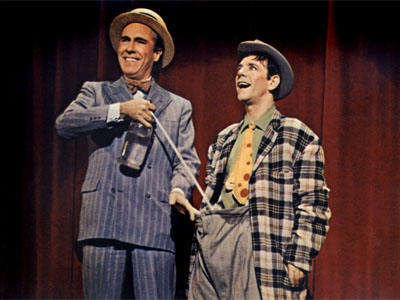
Next Tuesday, The Movie Channel — which you may or may not get on your local cable provider — is running The Night They Raided Minsky's. This film, which I find fascinating, has never been out on Laserdisc or DVD, the VHS tape is quite hard to find, and if it's ever been on TV before, it's been quite a while.
It stars Norman Wisdom, Jason Robards, Britt Ekland, Elliott Gould, Denholm Elliott, Jack Burns and Bert Lahr in a funny (at times), chaotic (usually) and silly (always) tale of the burlesque business and what allegedly ended it. As a historical record of that industry, it's a trainload of cheap fiction, but there are moments when some apparently genuine Burley-Q routines and ambiance sneak in around the edges, and some of the performances are quite wonderful. And, hey, the poster was rendered by Frank Frazetta and it has scantily-clad ladies on it, so that makes it special right there.
The film was produced by Norman Lear and Bud Yorkin, and directed by William Friedkin. Legend has it that, shortly after filming was completed, Mr. Friedkin decided it was a stinkeroo and abandoned it…whereupon the famed film editor, Ralph Rosenblum, came in and re-cut it into quite a different film than the one Friedkin had disowned. Or, at least, that's how Rosenblum told it in his book, When the Shooting Stops, in which he also claims to have salvaged a number of other cinematic disasters, including The Producers, A Thousand Clowns and all of Woody Allen's early directorial efforts.
Minsky's is so full of odd cutting, continuity errors and editors' tricks that one can believe Rosenblum's account. (None of the black-and-white stock footage, for instance, was in it when Friedkin left.) Adding to the problems was that Bert Lahr died during filming. His role was trimmed back and a few posthumous scenes were concocted with another ex-burlesque comic, Joey Faye, playing Lahr with his back to the camera, and Will Jordan dubbing the voice. Anyway, all of this makes the film more interesting, at least to me, and there are plenty of wonderful scenes that stand on their own. Here are a few other sidelights to note…
- The songs are by Lee Adams and Charles Strouse, and they're pretty good. Some of them remain in a stage version which has recently been written, though with an entirely-different plotline. It was announced for production, but suspended due to the death of director Michael Ockrent. His widow, Susan Stroman — who, thanks to The Producers, is the hottest director on Broadway — is said to be planning to stage the show…one of these days.
- The role of Duffy, the straight man who sings "Take Ten Terrific Girls," was played by Dexter Maitland, who was an actual Minsky's straight man. I met him when he was in his early 90's, playing in sketches in a Minsky's revue at the Hacienda Hotel in Las Vegas. He was a lovely man and he really made straight-manning an art.
- Another genuine burlesque veteran, Herbie Faye, plays the owner of the delicatessen. In his burlesque days, Faye was teamed for a time with Phil Silvers. When Silvers landed the TV show, You'll Never Get Rich (aka Sgt. Bilko), the first thing he did was find a recurring role for his old partner.
- The tall, long-limbed male dancer is the late Will B. Able, who appeared for years in TV variety shows and kids' specials. And one of the comics is played by the wonderful Eddie Lawrence. Eddie, with whom I had the joy of working once, is a multi-talented gent. He has written for and starred on Broadway…he has done cartoon voices and he paints (he inherited the studio of his dear pal, Zero Mostel). Beyond all that, he's best known for the comedy records on which he played his immortal character, The Old Philosopher. ("Is that what's botherin' you, Bunky?")
- Here's the most obscure trivia item in the history of World Cinema. One of the plot points revolves around a naughty pamphlet detailing the exploits of one Mademoiselle Fifi. If you look closely in the scene where the censor-guy is holding the pamphlet up to the light, you can see that the insides are made up of a page from an issue of Mad Magazine that was on sale when they were filming the movie. (It's an article illustrated by Bob Clarke on "Protest Buttons Through History.")
And there are some others but you get the idea. I'm not recommending this as a wonderful film, because it isn't. It's just a lot of fun, especially if you know some of the odd aspects of its birth.